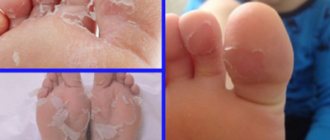Treatment of stomatitis
Treatment of stomatitis on the tongue of a child requires a careful approach. Diet plays an important role in this matter. It is important to exclude excessively hot foods and solid foods, such as meat, nuts, crackers, etc. from the baby’s diet.
Ulcerative stomatitis in children occurs as a result of a weakened immune system caused by a number of reasons, which most often include the flu or a cold. Treatment also requires the right approach. Frequent rinsing of the mouth with special herbal tinctures and antiseptic solutions helps.
Herpetic stomatitis
Herpetic stomatitis most often occurs in children aged 1 to 3 years. It develops when a baby is initially infected with the herpes virus. Typically, herpetic stomatitis in a 1-year-old child occurs in an acute form. In older children, it has a chronic course, in which periods of remission alternate with exacerbations, usually against a background of weakened immunity.
Herpetic stomatitis in its acute form has a pronounced clinical picture. With this stomatitis, the mucous membrane in the mouth becomes swollen, red, and small rashes of blisters appear on it, usually in groups. The transparent contents of the bubbles quickly become cloudy, after which they burst, forming numerous bright red erosions. Very quickly, erosions become covered with a yellowish or whitish coating. In the first 1-2 days from the onset of the disease, the body temperature rises to 37.5-40ºC, the baby feels unwell, muscle pain, and headache. His submandibular lymph nodes are enlarged.
Treatment
- Antiviral drugs . Parents should know that under no circumstances should ointments and creams against herpes be used in the mouth for the lips and face. There are special preparations that are used in the oral cavity in children. Most often, the child is prescribed Viferon, which contains interferons (have antiviral and immunostimulating effects) and vitamins E and A. For small children, the drug is conveniently available in the form of rectal suppositories. Older children can use Viferon gel, which is applied directly to the oral mucosa.
- Rinsing with antiseptic solutions . Most often, for herpetic stomatitis, rinsing with Miramistin solution is recommended.
- Immunomodulators . To increase general immunity, you can use Sodium Nucleinate, Amiksin, Immunal. Local immunity is well enhanced by Immudon and special pastes, for example, Splat.
- Antipyretic medications . If a child has a high body temperature, you need to give him an antipyretic, preferably paracetamol-based.
How to treat stomatitis?
Nowadays, there are many ways, if you turn to modern medications. But here the help of a professional doctor will not hurt, since you must first determine the subtype of this unpleasant disease. Recommendations from an experienced physician will help quickly cure the disease. On the contrary, self-medication can cause serious consequences and harm your child’s health. If you suspect that a child has stomatitis on his tongue, you should urgently consult a dentist and then begin treatment. Although folk remedies can help, they should still be used as a last resort, combining treatment prescribed by a doctor and rinsing the mouth with tinctures.
How many days do people suffer from stomatitis and what to do at the first signs of it?
How long does stomatitis last? This question is of great concern to parents of sick children, since all the symptoms of the disease are unpleasant and cause discomfort to the child.
The duration of the disease depends on its form. Acute variants of stomatitis with adequate drug treatment resolve within 14 days.
If the disease does not go away for a month or more, then they talk about the chronic course of such a pathology. In this case, it is possible to alternate periods of subsidence of clinical symptoms and their exacerbation - recurrent stomatitis.
If you suspect signs of stomatitis in your child, you should urgently consult a doctor who will tell you how to numb the mucous membrane and prescribe comprehensive treatment. If it is not possible to visit a doctor as soon as the first symptoms of the disease begin, then it is possible to independently numb the mouth with local drugs (Dentinox, Kalgel). And you can’t delay medical consultation!
Causes of stomatitis
There are many causes of stomatitis. In addition to the aforementioned weakening of the immune system, the development of the disease is facilitated by bacteria and microbes entering the child’s body. Also, stomatitis on a child’s tongue can occur due to fungal diseases. Fungi usually affect the mucous membrane of the tongue of infants. Please note that the use of sugar-containing mixtures is not recommended; they aggravate the situation and can provoke illness. Often, worms are found in children, which often contribute to the occurrence and development of ulcerative stomatitis. It happens that a child’s tongue is injured from sharp contact with teeth or a hard object. Such accidental injuries can easily cause stomatitis in a child. It is important to remember that in children the oral mucosa is fragile and tender and is easily injured.
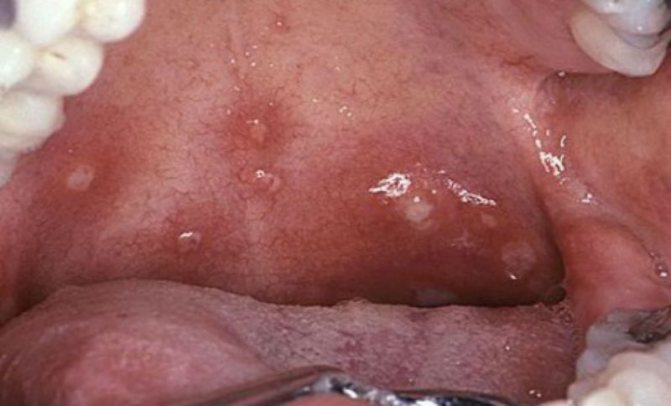
Types of childhood stomatitis and their main manifestations
The classification of childhood stomatitis is based both on the cause of the disease and on some distinctive features in the clinical course of such pathology. We will tell you how to determine this or that type of disease in our article later.
Catarrhal stomatitis
It is the mildest and most common form of the disease. In this case, multiple inflammatory foci appear on the mucous membrane of the gums, cheeks or lips, covered with a whitish coating, but without the formation of aphthae or ulcers. In this case, the child will complain of pain in the mouth when eating, drinking or talking, increased salivation, bad breath, and general weakness.
With catarrhal stomatitis, the mucous membrane is very susceptible to injury and bleeding, even during normal activities: brushing teeth, eating. When inflammatory foci are localized only on the gums, the clinical picture of stomatitis will resemble gingivitis.
Ulcerative stomatitis
The ulcerative form is a consequence of untreated catarrhal stomatitis. In this case, against the background of edematous foci of redness, multiple ulcerations are formed, which gradually increase in size, spread deep into the tissue of the mucous membranes or merge with each other.
The child complains of severe pain in the oral cavity, which intensifies when trying to brush his teeth or eat, and the smell of his breath becomes putrid. General health worsens: body temperature rises, weakness and body aches occur.
Young children are capricious, refuse to eat, and have trouble sleeping.
Gangrenous stomatitis
The gangrenous form of the disease is a continuation of catarrhal and ulcerative forms. A characteristic sign of this pathology is the spread of the inflammatory process deep into the tissues of the jaw with the development of extensive necrosis, which can involve the bones and spread to other anatomical areas.
The condition of a child with gangrenous stomatitis is extremely serious. There may be disturbances of consciousness, severe weakness, and the smell of rotting meat from the mouth. Regional lymph nodes are enlarged and painful on palpation.
Candidiasis (fungal or milk) stomatitis
Candidal stomatitis is characterized by specific symptoms. At the onset of the disease, children have dry mouth. Subsequently, a burning sensation and an unpleasant aftertaste appear. A white coating in the form of small dots is deposited on the mucous membrane. As the process progresses, the points merge into a large lesion that resembles a curdled mass. Such plaque is difficult to remove, exposing the inflamed surface of the mucous membrane.
Types of stomatitis
If we talk about the subtypes of the disease, then the following stand out:
- Candidal stomatitis, which quickly affects the gums and tongue, as well as herpetic stomatitis, which affects only the tongue.
- Bacterial stomatitis is considered a simpler type of disease and goes away relatively quickly. It is formed when eating unwashed foods, mainly.
- Allergic stomatitis, as a rule, is less common than other subtypes of this disease. Appears when consuming allergy-causing products or introducing infection through an open wound.
Determining which subspecies a child is suffering from is a rather difficult and thankless task. In any case, it is necessary to use antibacterial medications, which should be used strictly as prescribed by the doctor. Why is this so important? It depends on the age of the child; there are medications that are contraindicated by age. For example, a child is four years old, but the instructions for use indicate that it can be used starting from the age of seven. In such cases, it is better not to take risks and not give such medications to a child whose age does not correspond to the specified one.
Parents are most often concerned about the speedy recovery of their child. With proper treatment, following all the doctor’s instructions, and long-term therapy, children recover within ten days. But even after completely curing the patient, it is worth remembering such an important thing as prevention. From time to time, it is necessary to monitor the condition of your offspring’s teeth, thoroughly wash his toys, and do not forget about basic hygiene.
It is very important to ensure complete cleanliness of the house, ventilate living areas, and spend more time with the baby outdoors. Include fresh fruits and vegetables and dairy products in your regular diet. It is important to keep your child away from sick children, since stomatitis is an infectious disease. It is advisable to give up bad habits. The body's resistance to infection becomes lower if someone smokes or drinks at home. Puffs of nicotine smoke and wine vapors weaken the immune system.
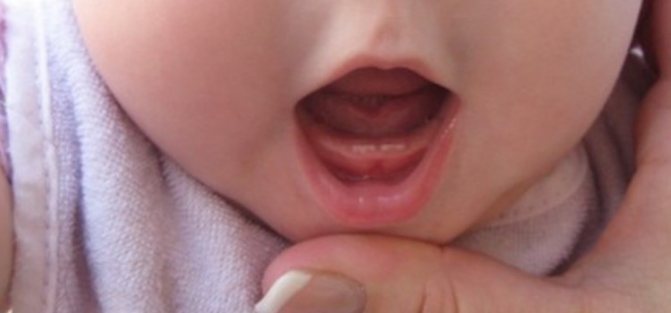
Prevention of stomatitis in children
- monitor oral hygiene (brush not only your teeth, but also your tongue);
- follow a diet;
- strengthen immunity;
- treat caries and gum disease in a timely manner;
- If an allergy is detected, eliminate its causes.
To summarize, it should be noted that treatment of stomatitis is possible only under the strict prescription of a doctor. In no case should you self-medicate, since the process can be started, and this can lead to complications and the fact that the disease will drag on for a long time: it will move from the acute stage to the chronic one.
Stomatitis and traditional methods of treatment
Although you should not try to cure childhood stomatitis on your own, many are concerned about the question of how to treat this disease at home, using the knowledge of traditional medicine. The most recommended methods are: rinsing the baby's mouth with soda and salt, propolis tincture, aloe juice. Garlic is an excellent antibacterial product and should be given to your child mixed with food.
There are many herbal infusions that can successfully help fight stomatitis at home. Chamomile, calendula, oak bark, blackberry leaves, St. John's wort, sage - cope well with the infection that has arisen. The listed herbs should be used to rinse the child’s mouth. To make an infusion, you need to mix two teaspoons of dry herbs and pour boiling water over them. The tincture is prepared for approximately three hours. But when fighting stomatitis, with the help of traditional medicine, it is necessary to constantly monitor the baby’s health. If it worsens, you should immediately contact a professional specialist.
How to treat stomatitis on a child’s tongue using folk remedies
Stomatitis is a common disease in young children. If symptoms of the disease appear, then parents should know how to treat stomatitis in children with home remedies.
Stomatitis is a common childhood illness that parents have encountered at least once in their lives. Children love to taste everything, so toys and other things magically end up in their mouths. Often this disease occurs if a child has used poorly washed utensils in public catering establishments.
Often, the symptoms of this disease develop against the background of a viral disease suffered by the child. Therefore, ARVI and stomatitis in children are directly linked. However, there is practically no connection.
Stomatitis develops as a result of decreased immunity and the entry of harmful bacteria into the oral mucosa. This may happen:
- when breastfeeding, if the mother does not ensure the cleanliness of the mammary glands;
- foreign objects getting into the child’s mouth;
- injuries caused during dental procedures;
- damage to the mucous membrane during brushing;
- due to an allergic reaction to oral hygiene products;
- due to burns, abrasions or scratches of the mucous epithelium;
- activation of the herpes virus due to decreased immunity;
- due to stress and lack of B vitamins, namely B12.
Here are the symptoms that signal the manifestation of this disease:
- Sores, swelling, and pimples will appear on the oral mucosa.
- There is an unpleasant odor coming from the mouth.
- The gums become swollen.
- The disease can occur without fever, and in some cases reaches 39 degrees and above.
- The child refuses to eat, sleeps poorly, is irritable, restless.
- A whitish, cheesy coating appears on the oral mucosa. The tongue becomes covered with whitish spots that are unevenly distributed. In this “color” it resembles a geographical map. This is what they call “geographical language”.
- The lymph nodes under the lower jaw enlarge and become painful.
This disease will not go away on its own, so parents should ask how to get rid of stomatitis with home remedies. This is especially true for cases of non-acute disease.
Stomatitis, the treatment of which is not difficult, has existed since ancient times. Traditional medicine has developed powerful, effective means and methods to combat this disease. Her recommendations will come to the aid of mothers who do not know how to treat stomatitis at home.
- Baking soda. Dissolve 2 tsp in a glass of warm water. baking soda, soak a cotton pad or gauze swab in the solution and wipe the upper palate, gums, and inner surface of the lips with this product. This will remove plaque and disinfect the oral cavity.
- Herbal tinctures - calendula, sage, chamomile, oak bark, yarrow. Drop 1 tbsp into a glass of hot water. l. medicinal collection and leave for 20 minutes. Wipe the baby's mouth with swabs soaked in a decoction of herbs. Older children can rinse their mouths with these infusions on their own.
- Kalanchoe juice has bactericidal properties. Apply it to the wounds in your child's mouth.
- Sea buckthorn oil helps heal ulcers.
- Tea rose petal jam is an effective and tasty disinfectant. It can only be used for children who have left infancy and for whom sugar is not contraindicated.
- Use a decoction of onion peels to rinse your mouth: pour 5 tbsp. l. brown onion peel 500 ml of boiled water, bring to a boil and leave for 8 hours. Strain and let your child rinse his mouth with the mixture.
- Freshly squeezed carrot juice, diluted with water, will help heal damaged areas of the mucous membrane. They need to rinse their mucous membranes.
- Aloe will have a bactericidal effect on damaged surfaces. Wash a leaf of the plant and invite your child to chew it. You can mix the crushed leaf with 1 tsp. honey
Knowing how to treat stomatitis at home, you will be able to quickly and adequately respond to the first symptoms and prevent the disease from developing.
Traditional medicine has means that will not only disinfect damaged surfaces, but also promote wound healing. Decoctions of medicinal herbs and aloe will not harm the baby’s health, so feel free to use them.
Noticed an error on the site? Select the text and press Ctrl+Enter or Cmnd+Enter

»/>
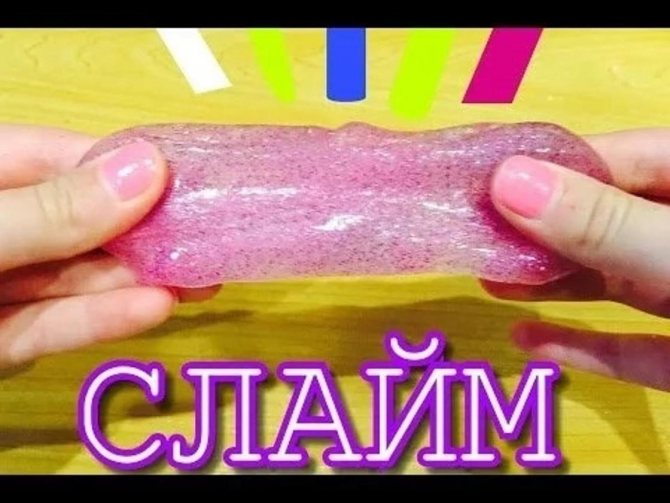
»/>

»/>

»/>

»/>
source
Stomatitis on the tongue is considered more of a disease in children, although it is also diagnosed in 20% of adult patients. Ulcers from stomatitis can cover the mucous membrane of the gums, the inner area of the cheeks and lips, and the tongue.
The causative agents of stomatitis are viruses, bacteria, and fungi in the mouth. Their activity is caused by weakened immunity or injury.
In a healthy person, millions of bacteria multiply on the mucous membrane of the tongue, which do not harm the human body under normal conditions. The thing is that the component of saliva - lysozyme - is a powerful antiseptic.
Stomatitis on the tongue develops only when several risk factors coincide: the body’s protective functions are reduced, trauma to the mucous membrane, and infection occur.
The tongue is an excellent breeding ground for viruses and bacteria. In a healthy person, harmful activity is suppressed by saliva. With insufficient functionality of the salivary glands, the concentration of dangerous microorganisms increases. A similar condition is observed with severe dehydration and diabetes.
Excessive bacterial activity causes plaque to form, and the tongue becomes covered with ulcers and wounds. During normal functioning of the glands, the microflora of the tongue mucosa changes when exposed to antibiotics and weakened immune system.
Very often, stomatitis on the tongue develops due to a viral infection. For the most part, the cause is the simple herpes virus. With this stomatitis, many small blisters first appear, which merge into blisters and turn into erosions.
With herpetic stomatitis, the temperature rises to critical values, and symptoms of severe intoxication appear. This form of the disease is much more severe than others. Herpetic stomatitis is a signal that the immune system is extremely weakened. Herpetic stomatitis often transforms into a chronic form and can worsen with stress, colds, or hormonal imbalance.
Candidal stomatitis very rarely affects adults. This form of the disease also indicates a weakened immune system. The disease often recurs with HIV, diabetes, and tuberculosis. With candidal stomatitis, a cheesy coating appears on the tongue, which hides the inflamed plaques. The disease is also accompanied by dryness, bad odor, and cracks in the mucous membrane.
Often, stomatitis develops against the background of chronic trauma from the brace system, or when wearing incorrectly selected dentures. At the tip of the tongue, pathology can develop due to malocclusion (constant biting).
Stomatitis most often develops in people who prefer solid foods with sharp edges (cereals, crackers, candies). The mucous membrane can be injured when exposed to broken teeth, sharp remains from severe caries.
Bacteria on the tongue can begin to actively multiply in conditions of insufficient oral care. With improper or infrequent brushing of teeth, dirty hands and uncleaned foods, there is a greater chance of developing stomatitis.
Language largely shows the state of the internal systems of the body. Relapses of stomatitis may indicate pathologies of the gastrointestinal tract: ulcers, colitis, gastritis, etc. If the disease recurs more than once a year, you should consult a gastroenterologist.
Often, ulcers on the tongue indicate helminth activity. Worm infestation causes frequent recurrences of stomatitis, often cyclical (once every 30-40 days).
If the patient follows the rules of hygiene and does not have bad habits, the cause of chronic stomatitis may be an allergy. Allergens from food, hygiene products, cosmetics or the environment are sufficient to activate the pathogen.
To reduce the number of relapses, you need to eliminate allergens, review your diet and carry out anti-allergy preventive therapy.
This pathology is often found in smokers. Compared to people who do not abuse cigarettes, they develop the disease 1.5 times more often.
Stomatitis also often affects people who bite their nails. From the surface of the fingers, billions of harmful microorganisms enter the mouth, which the immune system cannot resist.
Mouth ulcers can occur due to poisoning by harmful elements. For stomatitis, even a one-time poisoning is enough, and constant poisoning will provoke frequent relapses.
You can be poisoned by substances in water, fumes from low-quality paint and varnish, using certain types of building materials. Most often, stomatitis occurs in people who process fertilizers and are constantly in contact with strong cleaning agents.
In adults, stomatitis on the tongue begins acutely. A slight malaise appears, the temperature rises to subfebrile levels (37.1-38°C). Symptoms of acute intoxication (muscle pain in the arms and legs, headache, weakness) and a temperature above 38°C occur only with a herpetic infection.
A symptom of herpetic stomatitis is increased sensitivity of the tongue. A white or yellowish coating appears. Sometimes, instead, redness and thickening appear on the tongue, which turns into swelling.
After 1-2 days without treatment, stomatitis becomes complicated by ulcers. They have smooth edges and a clear halo. Swelling of the tongue and signs of epithelial detachment are noticeable. The pain intensifies so much that it becomes too painful for the patient to chew food and even talk.
Additional symptoms of stomatitis:
- increased bleeding of gums;
- unpleasant odor;
- excessive or insufficient salivation.
Stomatitis on the tongue at an early stage can be cured on your own with the help of conventional medications that are in your home medicine cabinet. If there is no effect after at least two days of treatment, you should definitely contact a dentist or therapist. The doctor will help clarify the diagnosis and select enhanced medications.
During the development of the disease, it is necessary to maintain oral hygiene, clean it after each meal and use antiseptic rinses. These rules apply to both adults and children.
Stomatitis on the tongue is not just an infection that causes discomfort. This is a dangerous disease that can result in serious speech impediment, severe inflammation and severe tissue damage. You can start self-treatment only at an early stage if you have the latest tools and experience. Otherwise, it is better to urgently contact a specialist.
The treatment regimen for stomatitis will depend on the cause of the disease. In this case, an integrated approach is required. To relieve pain, use gels with lidocaine (Kamistad, Dentinox, Lidochlor, etc.). You can use drugs for stomatitis with an analgesic effect (Cholisal, Hexoral). Lozenges are not recommended. They will only contribute to traumatizing the mucous membrane of the tongue.
Treatment options:
- Herpetic stomatitis. Oxolinic ointment, acyclovir, Zovirax. Immunostimulating agents (immunal, viferon, cycloferon) are also needed. Vitamin complexes for general strengthening will not be superfluous.
- Cholisal and solcoseryl denta can eliminate inflammation, as well as heal cracks and ulcers. Sometimes doctors recommend oil solutions with vitamins A, C, E.
- It is better to treat a bacterial infection with a solution of chlorhexidine, furatsilin, miramistin. Ointments with metronidazole and antiseptic sprays, the stream of which treats the entire mucous membrane of the tongue and reaches the root (hexoral, chlorophyllipt), will be effective.
- Fungal stomatitis responds to antifungal drugs such as miconazole, clotrimazole, and nystatin. It is recommended to combine the use of ointment, cream or gel with rinsing with an alkaline solution. To prepare such a solution, you need to dilute a tablespoon of baking soda in a glass of water (warm). Local treatment should be carried out three times a day, alternating with rinsing. Be sure to rinse before bed.
- For stomatitis caused by allergies, you need to take general-spectrum antihistamines (Tavegil, Zyrtec, Fenistil, Claritin).
- When stomatitis is combined with a disease of the gastrointestinal tract or endocrine system, measures must also be taken to eliminate the underlying disease.
- You can speed up the healing process of ulcers by application (applying a layer of the drug). For these purposes, use calendula ointment or Actovegin.
- Ulcers on the tip of the tongue can be directly lubricated with ointment or gel. When processing the solution you need to use a cotton swab.
The differences between childhood stomatitis are rapid development and more acute course. In the case of a child, you should not skip visiting a doctor even with mild symptoms.
Treatment for stomatitis in children is similar to treatment for adult patients. Anesthesia, drugs against the causative agent of the disease and agents that will promote accelerated wound healing are required.
The problem with pediatric therapy is the limited list of approved drugs. Antifungal ointments are prohibited for the child; it is better to replace them with rinsing with soda. Also, children cannot use acyclovir, but it can be replaced with oxolinic ointment.
It is quite possible to cure stomatitis using home remedies. A decoction of chamomile or calendula is suitable as a pain reliever. Aloe and Kalanchoe juices help speed up the healing process. They need to treat ulcers 2-3 times a day.
Herbal solutions for rinsing should be brewed in boiling water. Take a spoonful of dry herbs for a glass of water. Be sure to infuse the solution for an hour and filter after cooling. You need to rinse with herbal infusion more than three times a day.
Traditional recipes for stomatitis:
- Hydrogen peroxide. Regular rinsing with this substance helps relieve pain. You need to dilute a teaspoon of peroxide in boiled water and gargle three times a day.
- Propolis. A tincture with an alcohol solution of propolis can relieve inflammation. You should dilute a spoonful of the solution in ½ glass of water. The effectiveness of this treatment can be increased by alternating with rinsing with peroxide.
- Aloe, Kalanchoe. Two more good remedies for inflammation. It is recommended to rinse your mouth with a solution of freshly squeezed juice from time to time or chew plant leaves.
- Garlic. This is a unique bactericidal agent that is good for stomatitis. You need to chop a few cloves of garlic and mix with fresh homemade sour cream. It is enough to keep the mixture on your tongue for 30 minutes several times a day.
- Potato. In the fight against stomatitis, you can use slices of raw potatoes or gruel.
- Carrot juice. Fresh carrot juice diluted with water is good as a gargle for tongue ulcers. It is necessary to carry out the procedure three times a day.
- Cabbage juice. Use in the same way as carrots.
- You can relieve pain from stomatitis with a solution of furatsilin or a weak solution of potassium permanganate.
Traditional medicine offers wound treatment products, decoctions, infusions and fresh plants. The advantage of the therapy is its naturalness, the absence of dyes and artificial additives. This is also a disadvantage, because the plant origin of natural ingredients can provoke allergies in the patient.
Many patients with stomatitis are helped by infusions and decoctions of medicinal herbs. In this case, the following plants are recommended:
- St. John's wort;
- anise;
- sea buckthorn;
- chamomile;
- sage;
- verbena;
- Eryngium flatifolia;
- horseradish;
- currant berries;
- calendula;
- bergenia;
- raspberries;
- Oak bark;
- Potentilla erecta;
- blackberry leaves.
All infusions can be prepared according to the same scheme: mix two teaspoons of herbs thoroughly, pour three glasses of boiling water, leave (preferably for several hours). You need to rinse your mouth with warm infusion. The course of herbal treatment is 10 days.
Recipes for stomatitis with herbs and available ingredients:
- Anise helps well with catarrhal and ulcerative lesions of the tongue. You need to steep a tablespoon of anise in a glass of boiling water for half an hour. Recommended for rinsing three times a day.
- An infusion of chamomile, calendula, verbena, bergenia and oak bark is also effective for stomatitis. You can only take those herbs that are available. The mixture must be poured with hot water and processed in a water bath for 15 minutes. Leave for 1-2 hours. This collection quickly copes with inflammation, relieves pain and disinfects the mouth.
- Safe methods for treating stomatitis at home include solutions with the juice of Kalanchoe, carrots and cabbage. These juices, diluted with water, are effective as a rub on ulcers and as a rinse throughout the mouth.
- For severe stomatitis, you can try stronger recipes. Ulcers can be lubricated with a mixture of novocaine (1 ampoule), vegetable oil (teaspoon), honey (teaspoon), and one egg white.
- Advanced stomatitis should be treated with a decoction of onion peels. For 100 g of husk you need to take 0.5 liters of water. Boil the broth for 15 minutes, then leave for 6-8 hours, strain. Then add boiled water equal to the amount evaporated. You need to drink the decoction warm three times a day.
Such treatment of stomatitis should be combined with the consumption of foods enriched with vitamins A, B, C, E.
Treatment with herbal infusions will be effective only with regular use. You should rinse your mouth three times a day with warm solutions. It is necessary to continue treatment even after the symptoms subside (a few more days), since the infection is not destroyed when the manifestations are eliminated.
Infants very often suffer from fungal stomatitis. The child becomes infected with infections through the pacifier and during feeding. If your baby has a whitish coating on the tongue and the inner surface of the cheeks, you need to take appropriate measures without delay. Sometimes, during an infection, the baby may refuse to breastfeed, which should attract the mother's attention.
There are very few safe remedies for stomatitis in children:
- You can use a soda solution: dissolve a dessert spoon of soda in a mug of water and lubricate pacifiers, toys and the mother's breast with it before feeding.
- Infants can be treated with a decoction of chamomile or calendula. Also, steam a dessert spoon of herbs in a glass of boiled water and leave for a couple of hours.
- For older children, rosehip or peach oil, flaxseed oil, and Kalanchoe juice are suitable. They can treat wounds.
- If the child already knows how to rinse his mouth properly, you can use a solution with protein: mix half a glass of water and egg white. You need to rinse three times a day.
- You can treat a 6-7 year old child for stomatitis using safe carrot or cabbage juice or potatoes.
- In severe cases, you can prepare a stronger remedy. You need to take a dessert spoon of birch leaves, two spoons of sage, three spoons of rose hips and a spoon of oregano. You are supposed to pour boiling water over everything and leave for a couple of hours. After settling, mix the solution with kombucha and leave for another three days. To achieve improvement in the child's condition, rinsing three times a day is required.
As for the prevention of stomatitis, doctors strongly recommend constantly and carefully caring for the oral cavity, and promptly treating caries and other foci of infection.
Recurrences of stomatitis can be reduced by regularly brushing your teeth twice a day. It is advisable to choose a paste with a disinfecting and anesthetic effect. Doctors also recommend rinsing your mouth every time after eating.
If the immune system is suppressed, pregnancy or illness progresses, you need to change the toothpaste to a product with chlorhexidine, which will protect the tongue from pathogens. A mouthwash is a must.
source
Children are designed that way that they need to taste everything. Babies try to put everything that doesn’t fit into their mouth. Older children often unconsciously lick their fingers and forget to wash their hands. This is why stomatitis occurs so often in childhood. Inflammation of the oral mucosa is a rather painful condition. But you can help a child with it not only with pharmaceutical drugs, but also with traditional medicine. We will talk about them in this article.
Stomatitis is a disease that is almost impossible to miss; any mother is able to detect the characteristic signs that a child has an inflammation of the oral cavity:
- Anxiety and bad mood of the child.
- Decreased appetite, pain when eating.
- Changes in the oral mucosa: redness, quite severe swelling, the appearance of ulcers with a white, gray or yellowish coating.
- Increased salivation, drooling.
- Sometimes you may notice bleeding gums.
- There is almost always an unpleasant odor from the mouth.

Doctors still cannot explain the true causes of stomatitis. The most obvious premise - poor hygiene - does not raise any questions. It is clear that pathogens that enter the oral cavity cause inflammation. But experts are inclined to believe that not only microbes are to blame for this unpleasant illness.
Sometimes stomatitis is provoked by certain immune processes. Presumably, such a reaction in the mouth occurs in cases where, for reasons that are not fully understood, the immune system cannot identify certain particles or molecules. According to the “logic” of immunity, since it is not identified, it should be destroyed, and an army of lymphocytes “rushes” at the mysterious guests. This is what causes ulcers to appear.
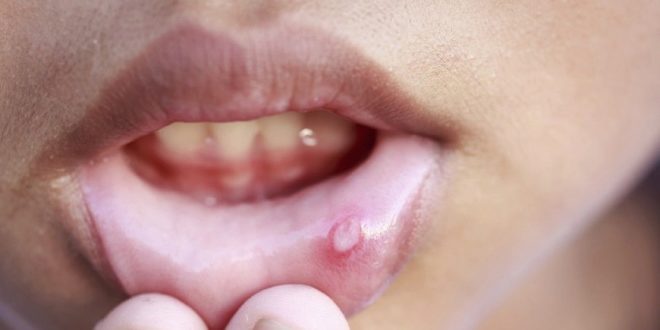
The most susceptible to the disease are children who have a poor and unbalanced diet, babies who have recently suffered from diarrhea, repeated vomiting, or intestinal infections, since they have some degree of dehydration.
If a child has taken medications that “dry” the mouth or reduce the amount of saliva produced (for example, antihistamines), he also has a fairly high risk of developing stomatitis. In adolescents during puberty, hormonal levels are unstable, and this is also a prerequisite for inflammation of the oral cavity.
Children with a genetic predisposition to this disease are often susceptible to stomatitis: if mom or dad often encounter this unpleasant condition, then there is a high probability that the child will inherit the high-quality composition of the oral microflora and will also suffer from stomatitis.
Poor-quality braces or their incorrect installation can also cause inflammation of the oral mucosa.

Treatment for ordinary stomatitis is not an extremely difficult task ; it is possible to cope with it in 7-12 days, including using remedies from the arsenal of traditional healers. Often stomatitis goes away on its own without treatment at all. But when it comes to children, there is no need to hope for this, because the lack of proper therapy can lead to complications and the spread of infection.

As with most childhood illnesses, the main danger lies in diagnostic errors. It would seem that a simple disease has a simple treatment. But in reality everything is much more complicated. The fact is that stomatitis may not be an independent disease, but only a symptom of more dangerous conditions, such as diseases of the stomach and intestines (gastritis, duodenitis, colitis and a number of others). Stomatitis may indicate that helminthic infestations are firmly established in the child’s intestines. In addition, ulcerative inflammation of the oral mucosa can also occur with HSV (herpes simplex virus), as one of the manifestations of herpetic infection.

Stomatitis can be both allergic and traumatic. The most common condition among young children is catarrhal disease; it is caused by a violation of hygienic requirements for the maintenance of the oral cavity.

Many parents believe that stomatitis is always contagious, so they immediately provide separate dishes for the sick child so as not to infect other family members. It is not always so.
Only vesicular stomatitis, which is of viral origin, is dangerous to others. Other forms of the disease are not transmitted through household contact.

An error in diagnosing the origin of the disease can cause serious consequences - inflammation can spread to the larynx, cause negative processes in the respiratory system, and even contribute to the development of a systemic infection.

Stomatitis in children differs from a similar diagnosis in adults in the frequency of its severe course. The imperfect immune defense of a child copes with security functions worse than that of an adult. Therefore, it is often possible to observe multiple ulcers in the child’s mouth, affecting both the inside of the cheeks and the tongue. At the same time, the temperature rises, the baby’s well-being deteriorates significantly, and severe pain syndrome appears. Such stomatitis requires the prompt use of antifungal agents, antiseptics and painkillers; sometimes doctors prescribe antiviral drugs. Doctors believe that it will be better if treatment of complex forms is carried out with pharmaceutical medications.
The opinion of expert Dr. Komarovsky about childhood stomatitis, and you can learn about situations when folk remedies alone cannot do it in the following video.
Most folk recipes are well known to parents. This is how they themselves were treated many years ago, but these remedies do not lose their relevance.

This recipe is the most common and cost-effective. A teaspoon of salt and the same amount of baking soda is all that is needed to prepare the solution. The ingredients should be dissolved in a glass of warm boiled water. You will get a single dose. You need to use at least 250 ml of liquid per rinse. A child should not swallow saline solution, so you should not practice such procedures for children who, due to their age, do not yet understand how to rinse their mouth properly. Soda-salt treatments for the oral cavity should be repeated every 2-3 hours.
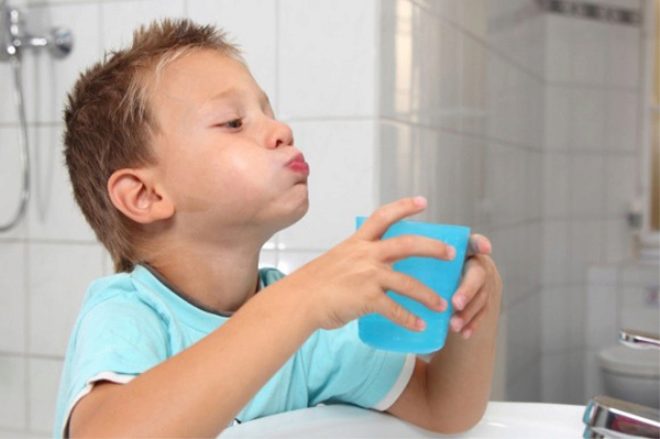
This herbal mixture costs mere pennies, but in terms of effectiveness it can be put on a par with expensive pharmacy antiseptics. To prepare the rinse, you will need a teaspoon of dried herbal raw materials (it is sold in pharmacies) and 200 grams of boiled water. Pour chamomile with non-hot water, place the container in a water bath and hold there for 15 minutes. Strain the resulting broth and cool at room temperature until warm. You need to let your child rinse his mouth with chamomile decoction 5-6 times a day; before spitting it out, the child must hold the liquid in his mouth for at least 30 seconds.
This is a plant that is a real mother’s assistant for various childhood ailments. For stomatitis, aloe juice can be used to treat mouth ulcers. To do this, you need to cut off a juicy leaf, keep it in the refrigerator for half an hour, and then carefully treat the damage to the mucous membrane with it. This method is not suitable if the child has multiple ulcerations. In case of severe illness, it is better to squeeze out aloe juice using a piece of gauze, dilute it with boiled water and rinse your mouth with this mixture every three hours.
Now few people have it in their home, but if you try to treat stomatitis with it, you will definitely later acquire this useful product. Rinse your mouth with the water in which the kombucha is standing 5 times a day. The total one-time volume of liquid for the procedure is 150 ml. Stomatitis in a child after such rinses goes away completely on the second day. After the first three or four rinses, the pain disappears and the ulcers begin to heal.
This plant has a pronounced anti-inflammatory and analgesic effect. To prepare the rinses, you will need to pour two tablespoons of herbal raw materials with water, the temperature of which does not exceed 90 degrees. The liquid should be infused under the lid. You can brew sage in a thermos. Exposure time is about an hour. You should rinse your mouth with the resulting infusion 4-5 times a day.
Eucalyptus leaves quickly and effectively relieve pain and discomfort from stomatitis. They should be crushed, brewed in a thermos and left for 3-4 hours. The resulting aromatic liquid should be filtered and the child should be given to rinse his mouth 3-5 times a day.
To prepare medicinal compresses you will need one raw potato. The tuber should be thoroughly washed, peeled, cut into small thin slices, which are applied to the affected areas of the oral mucosa for 15-20 minutes. You can not cut the potatoes, but grate them on a coarse grater and lubricate the oral cavity with the resulting mass. Leave for 15 minutes and then rinse with clean boiled water. Potatoes have a strong healing property, which allows you to cope with the manifestations of stomatitis in literally 3-4 days.

Do not underestimate stomatitis and assume that the child is not in danger. If the baby’s immunity is weakened and the disease is severe, the infection can quickly spread to neighboring areas, such as the nasopharynx and larynx. In addition, pathogens in food enter the digestive tract. Therefore, if you really want to treat the child yourself, go ahead. But remember about the “critical” periods of self-medication: if stomatitis does not go away within 7 days, you should immediately consult a doctor.

- Do not burn mouth ulcers with alcohol-containing compounds, or use iodine or brilliant green for this.
- During treatment for stomatitis, you should not feed your child too hot, spicy or cold food, as it can increase inflammation and definitely increase pain.
- During treatment, the child should not use “aggressive” toothpastes to brush his teeth; it will be better if he uses special children’s toothpastes with o.
Another useful video from the “Children’s Doctor” episode dedicated to childhood stomatitis can be viewed in the following video.
When stomatitis occurs in an infant, it is impossible to rinse, so medicinal solutions are prepared for babies according to the above recipes and the mouth is treated either with cotton swabs and small cotton swabs.

medical reviewer, psychosomatics specialist, mother of 4 children
source
Prevention
Prevention is paramount and children should not be allowed to become acquainted with such an insidious disease as stomatitis. Look at the photo to see what stomatitis looks like and how to treat it in children at a given age, depending on what provoking factor it is caused by. Children are not immune from household microtraumas when they put dirty toys and foreign objects into their mouths. Infection of the oral cavity can occur unnoticed, which parents should be aware of.
Worth recommending:
- visit the dentist more often, at least 2 times a year;
- do not use preparations containing alcohol to avoid burns;
- maintain oral hygiene;
- Constantly disinfect toys and prevent babies from putting things in their mouths;
- choose a good toothpaste and brush;
- harden the child's body.

Proper prevention will prevent the development of the disease
Look at the photo of the disease at different stages of development, so it is important to understand how to treat stomatitis in children on the tongue and what to do in emergency cases, even if suddenly ulcers on the tongue appear spontaneously, and have nothing to do with other family members. It happens that a child injures his tongue and an oozing ulcer appears on the tongue. It is necessary to quickly treat with antiseptics without starting the process. Often, infants suffer from thrush or milk stomatitis, when it is important to treat the surface of the mouth with a soda solution and even the pacifier when putting it into the mouth. The main thing is to understand that the inflammatory process in the mouth will not lead to anything good. When the first alarm bells appear, you should not hesitate to contact a doctor, and self-medication can greatly aggravate the situation.






